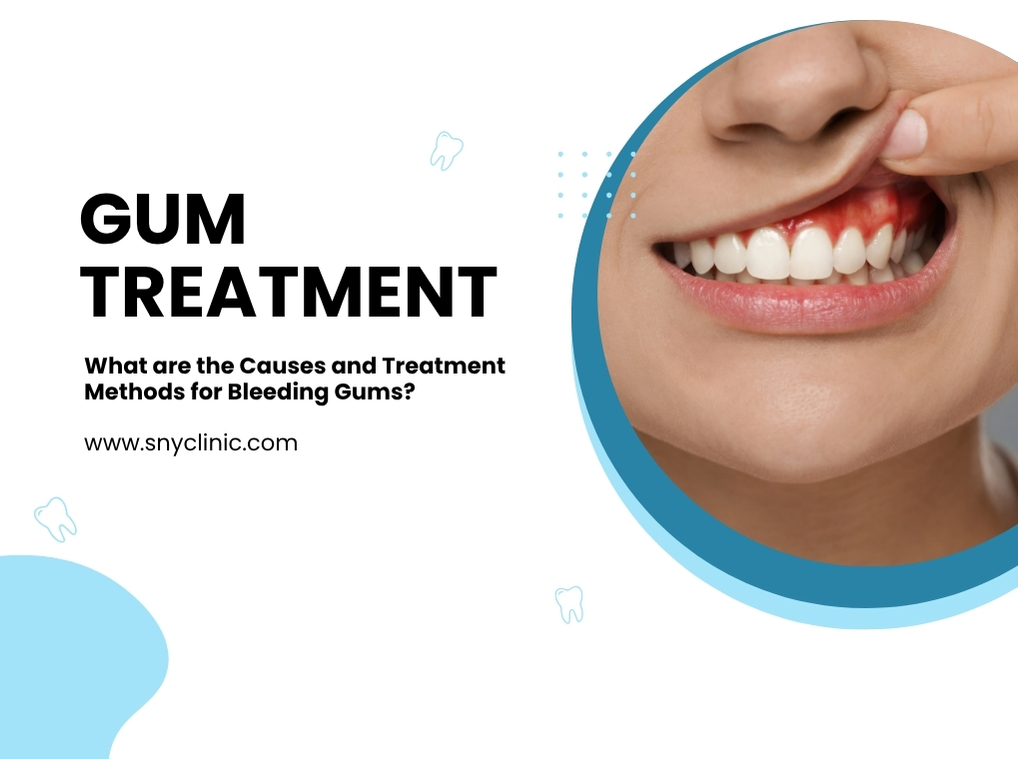
Causes and Treatment Methods of Gum Bleeding
Causes and Treatment Methods of Gum Bleeding
Seeing a few drops of blood in the sink while brushing your teeth may seem trivial. However, this small sign could be the first indication of a more serious oral health problem. Gum bleeding, often overlooked, can develop into severe periodontal diseases if left untreated. In this article, we will thoroughly examine the main causes of gum bleeding, the situations in which it should be taken seriously, and effective treatment methods.
What Is Gum Bleeding?
Gum bleeding occurs when the gums become sensitive and bleed easily in response to external stimuli. This condition usually appears while brushing, flossing, or eating. Mild bleeding that occurs rarely may be considered normal in some cases. However, if the bleeding is recurrent, it could be a sign of gingivitis or some systemic health problems.
Causes of Gum Bleeding
1. Early-Stage Gum Problems (Gingivitis)
The most common cause of gum bleeding is early-stage inflammation of the gums. When oral hygiene is inadequate, bacterial plaque accumulates on the tooth surface. Over time, this bacterial layer causes inflammation, leading to sensitivity, redness, and bleeding in the gums.
2. Advanced Gum Diseases (Periodontitis)
If inflammation in the gums is not controlled in time, it can spread to deeper tissues, resulting in a more advanced gum disease known as periodontitis. This condition may damage the bone tissues surrounding the teeth and can eventually lead to tooth loss.
3. Improper Brushing Techniques
Using toothbrushes with very hard bristles or brushing too aggressively can damage and irritate the gums.
4. Improper Use of Dental Floss
Using floss with sudden and uncontrolled movements can cause small tears along the gum line. This is especially common in individuals not accustomed to flossing.
5. Vitamin and Nutritional Deficiencies
A deficiency in essential micronutrients, particularly vitamins C and K, can weaken the gums. This can make bleeding easier and reduce resistance to infections.
6. Hormonal Changes
During periods of significant hormonal fluctuations such as pregnancy, puberty, menstruation, and menopause, the gums can become more sensitive and prone to bleeding, even with minimal contact.
7. Tobacco and Alcohol Use
Smoking and alcohol consumption damage the soft tissues in the mouth. They also suppress immune responses, exacerbating gum inflammation and delaying healing.
8. Side Effects of Medications
Certain blood thinners, blood pressure medications, or chemotherapy drugs may cause gum bleeding as a side effect. Regular dental check-ups are important while using these medications.
9. Chronic or Systemic Diseases
Diseases such as diabetes, blood disorders, or immune-related conditions can lower the gums' resistance to infection, increasing the risk of inflammation and bleeding.
Symptoms of Gum Bleeding
Gum problems can lead to more serious conditions over time. If you experience the following symptoms, you may be facing gum disease:
• Frequent bleeding during brushing or eating
• Swelling, redness, or tenderness in the gums
• Gum recession, exposing the root surface
• Persistent bad breath
• Loosening or wobbling of teeth
• Occasional metallic taste in the mouth
If you have these symptoms, it is very important to consult a dentist promptly for your oral health.
How Is Gum Bleeding Treated?
The treatment method depends on the underlying cause of the bleeding. Here are some common treatment approaches:
✅ Professional Dental Cleaning (Scaling)
Hard deposits on tooth surfaces can cause gum inflammation and damage. When removed by a professional dentist, gums can begin to heal and restore their natural structure.
✅ Medical Mouthwashes and Antibiotics
To control gum infections, special antiseptic mouthwashes may be recommended. If necessary, short-term antibiotic treatment may be initiated under the supervision of a dentist.
✅ Periodontal Surgery
If gum disease has progressed, standard treatments may not be sufficient, and direct intervention may be required. In such cases, surgical procedures like curettage, which involve deep cleaning of the root surfaces, may be performed.
✅ Personalized Oral Care Plan
Your dentist can create a customized cleaning routine based on your oral structure and needs and recommend products to use in your daily care. This personalized approach is very effective in preventing future gum problems and maintaining your current oral health.
Gum bleeding often begins silently but can progress to tooth loss if left untreated. Therefore, instead of assuming it will go away on its own, it is essential to take this warning seriously and seek professional support.
Healthy gums are the foundation of a healthy smile. Act without delay and do not let a small amount of bleeding turn into a major problem.




